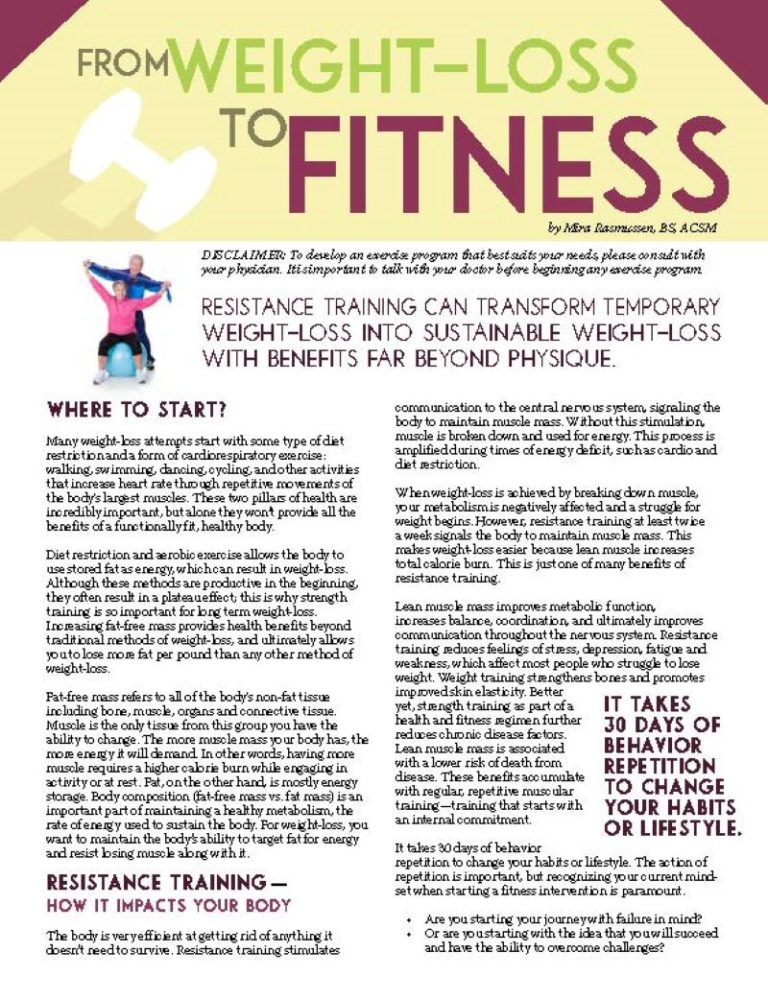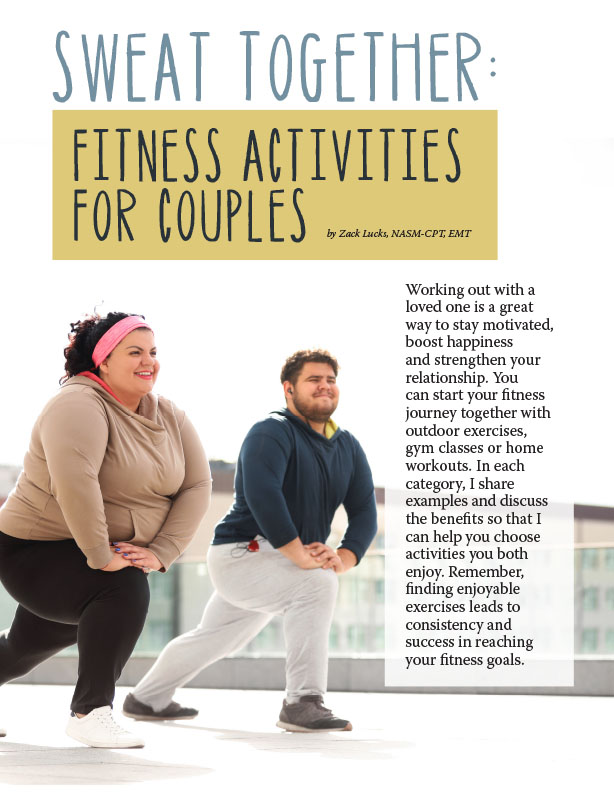From Weight-loss to Fitness


by Mira Rasmussen, BS, ACSM
Spring 2014
DISCLAIMER: To develop an exercise program that best suits your needs, please consult with your physician. It is important to talk with your doctor before beginning any exercise program.
Resistance training can transform temporary weight-loss into sustainable weight-loss with benefits far beyond physique.
Where to Start?
Many weight-loss attempts start with some type of diet restriction and a form of cardiorespiratory exercise: walking, swimming, dancing, cycling, and other activities that increase heart rate through repetitive movements of the body’s largest muscles. These two pillars of health are incredibly important, but alone they won’t provide all the benefits of a functionally fit, healthy body.
Diet restriction and aerobic exercise allows the body to use stored fat as energy, which can result in weight-loss. Although these methods are productive in the beginning, they often result in a plateau effect; this is why strength training is so important for long term weight-loss. Increasing fat-free mass provides health benefits beyond traditional methods of weight-loss, and ultimately allows you to lose more fat per pound than any other method of weight-loss.
Fat-free mass refers to all of the body’s non-fat tissue including bone, muscle, organs and connective tissue. Muscle is the only tissue from this group you have the ability to change. The more muscle mass your body has, the more energy it will demand. In other words, having more muscle requires a higher calorie burn while engaging in activity or at rest. Fat, on the other hand, is mostly energy storage. Body composition (fat-free mass vs. fat mass) is an important part of maintaining a healthy metabolism, the rate of energy used to sustain the body. For weight-loss, you want to maintain the body’s ability to target fat for energy and resist losing muscle along with it.
Resistance Training — How it Impacts Your Body
The body is very efficient at getting rid of anything it doesn’t need to survive. Resistance training stimulates communication to the central nervous system, signaling the body to maintain muscle mass. Without this stimulation, muscle is broken down and used for energy. This process is amplified during times of energy deficit, such as cardio and diet restriction.
When weight-loss is achieved by breaking down muscle, your metabolism is negatively affected and a struggle for weight begins. However, resistance training at least twice a week signals the body to maintain muscle mass. This makes weight-loss easier because lean muscle increases total calorie burn. This is just one of many benefits of resistance training.
Lean muscle mass improves metabolic function, increases balance, coordination, and ultimately improves communication throughout the nervous system. Resistance training reduces feelings of stress, depression, fatigue and weakness, which affect most people who struggle to lose weight. Weight training strengthens bones and promotes improved skin elasticity. Better yet, strength training as part of a health and fitness regimen further reduces chronic disease factors. Lean muscle mass is associated with a lower risk of death from disease. These benefits accumulate with regular, repetitive muscular training—training that starts with an internal commitment.
It takes 30 days of behavior repetition to change your habits or lifestyle. The action of repetition is important, but recognizing your current mind-set when starting a fitness intervention is paramount.
- Are you starting your journey with failure in mind?
- Or are you starting with the idea that you will succeed and have the ability to overcome challenges?
Once you decide on success, picture it. Picture what success looks and feels like, beyond your physique. Think of the actual feelings you will experience of joy and accomplishment. Then, practice seeing and feeling that outcome. You may have to intervene discouraging thoughts one hundred times a day, or maybe just a few, but this is the most important exercise you will do to create success in life-long fitness. This mental exercise will serve as a great tool to overcome any barriers or challenges you encounter. And, like any exercise, you will get better at it with each set, repetition and workout.
Time to Start
When starting a strength training routine, consider what factors will produce a positive response and encourage future behavior. If you are unsure of how to perform an exercise, use machines that guide your movement or review exercises using reputable sources and videos online.
Limitations of any kind can be accommodated during workouts, especially if you meet with a degreed and certified exercise physiologist who will know how to design the best workout for you. Whether you are starting a routine for the first time or starting again after some time off, a routine that produces a positive response will encourage regular workouts.
In making the transition from weight-loss to fitness, it’s important to use a routine that is structured to fit your goal. Even though high intensity exercise programs have gained popularity, they have also produced a high rate of injury. Resistance training develops your central nervous system as well as your muscle tissue. These physiological adaptations must take place before introducing complex exercises with high intensity. Start training with a total body workout for the first three months. Gain confidence by practicing good form with light to medium weights. Then allow intensity to build by increasing sets, reps and resistance. These concepts will keep your body healthy while training so you reap the benefits without injury.
Consider these points when starting a resistance training program:
Large muscle groups first:
Your body is a machine that works together, not in individual parts. By targeting large muscles first, you allow smaller muscles to do their job in assisting larger muscles, instead of exhausting them prematurely and reducing the effectiveness of your workout. Start your workout with exercises that work the chest, back, quadriceps, hamstrings and shoulders. Then, do exercises that focus on the abdominals, biceps, triceps, forearms and calf muscles.
Control/safety:
Faster is not better. Exercises should be performed deliberately and in a controlled manner. This helps build muscle and keep your body free from injury.
Full range:
Make sure to move through the full range of motion of the exercise, and avoid small jerky movements.
Breath:
Exhale when you are shortening/tightening your muscles and inhale when you are releasing/relaxing your muscle. Make sure to breathe; do not hold your breath.
Number of exercises:
Choose between eight to twelve exercises, at least a single exercise for each muscle, creating a total body workout.
Sets:
For larger muscles, do between two to four sets. For smaller muscles, do two to three sets.
Strength/weight and reps:
Start with a weight that feels light to moderate. The selected resistance should allow you to complete eight to twelve repetitions per set. The amount of reps should produce muscle fatigue, but not exhaustion. Increase weight as the reps become easier. Use caution, increase weight in small increments. Always practice good form before increasing resistance.
Frequency and rest:
Improved muscle function is best gained by training two to three times per week. Make sure to include rest periods of 36 to 48 hours between working the same muscle groups. Example: For a total body workout, train every other day or every two days.
Example of a Total Body Muscular Fitness Routine for the Beginner
– Train 2-3 times per week
– At least a 36-48 hour rest period between workouts
– 2-3 sets of each exercise, 8-12 repetitions per set
– Moderate resistance
- Chest Press – Machine, dumbbells, tubing
- Low Row – Machine, tubing
- Lat Pull-Down – Machine, tubing
- Wall Squats – Bodyweight, stability ball
- Bridges – Floor
- Shoulder Press – Dumbbells, tubing
- Abdominal Crunch – Machine, stability ball, bodyweight lying face-up
- Low-Back Extension – Machine, bodyweight lying face-down
- Biceps Hammer Curl – Dumbbells, tubing
- Triceps Kick-Back – Dumbbells, tubing
- Calf Raises – Machine, Standing with bodyweight
Conclusion
Strength training essentially halts the roller-coaster of weight-loss and weight gain in its tracks, allowing you to become more than just a person who weighs less, but a person that can maintain their weight and take the next step into fitness. Maintaining or increasing muscle mass is the key to a healthy body composition and will affect your health in ways cardiorespiratory exercise and diet alone cannot.
A true fitness intervention includes visualizing your success mentally as well as exercising physically. Choosing an exercise atmosphere and routine that you can derive some enjoyment will help you exercise with confidence and ensure future workouts. A well-structured training program should allow for physical adaptations to occur before increasing intensity. Start with a total body routine that will allow the body to work better as a whole. When you combine the power of lean muscle mass to a healthy diet and cardiorespiratory exercise, you will see the transformation from temporary weight-loss to improved fitness and long term weight-loss.
About the Author:
An exercise physiologist and health professional for the last eight years, Mira Rasmussen BS, ACSM, is passionate about personalizing the path to wellness and being a guide through that life-changing process. She has worked with all populations and has utilized her psycho-physiological skills in eating disorder recovery, addiction, corporate wellness, personal training, and nutrition. Mira has worked side by side with renowned dietitians, doctors and psycho-therapists using physical fitness as a vital tool for clients to reach and sustain a well-balanced life.
by Zack Lucks, NASM-CPT, EMT Winter 2024 Working out with a loved one is a great way…
Read Articleby Nina Crowley, PhD, RD (with Inspiration from Shawn Cochran) Winter 2024 Dating, no matter your age,…
Read Articleby Michelle “Shelly” Vicari Fall 2023 Playing youth sports is a fantastic way to boost health and…
Read Article









